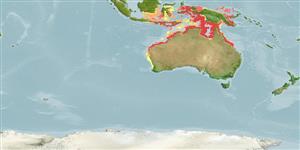Environment: milieu / climate zone / depth range / distribution range
Οικολογία
Θαλασσινό(ά) βενθικό(ς); ωκεανόδρομο(ς); εύρος βάθους 0 - 36 m, usually ? - 36 m (Ref. 6205). Tropical; 0°S - 35°S, 111°E - 150°E (Ref. 6205)
Western Central Pacific: Indonesia, southern New Guinea and northern Australia. Frequently confused with Sillago maculata which occurs in eastern Australia.
Length at first maturity / Μέγεθος / Βάρος / Age
Maturity: Lm 13.4, range 13 - 13.9 cm
Max length : 36.0 cm SL αρσενικό/απροσδιόριστο; (Ref. 6205)
Ραχιαίες άκανθες (συνολικά): 12; Μαλακές ραχιαίες ακτίνες (συνολικά): 19-21; Εδρικές άκανθες 2; Μαλακές εδρικές ακτίνες: 18 - 20; Σπόνδυλοι: 34 - 36. Swim bladder with four anterolateral extensions that are more complex than S. aeolus, but much shorter than S. maculata. Body coloration is very similar to S. maculata and S. aeolus. Body with oblique bars which are not joined as in S. maculata. The upper blotches are small, the black spot at the base of the pectoral fin is indistinct. The lateral silvery stripe is noticeable but may be quite faded.
Most abundant on silty-sand or muddy substrates. Large adults feed near gutters and sandbars inside Shark Bay and move into deeper waters of marine embayments. Juveniles frequent seaweed banks and broken bottom and occur in large numbers near mangrove creeks. They enter coastal rivers in the Swan and Mandurah estuaries in western Australia. Oviparous (Ref. 205), and are multiple spawners with synchronous development (Ref. 36823). Juveniles and adults are commonly trawled with S. robusta and S. lutea (Ref. 6205). Marketed fresh (Ref. 9679).
Multiple spawners with synchronous development (Ref. 36823).
McKay, R.J., 1992. FAO Species Catalogue. Vol. 14. Sillaginid fishes of the world (family Sillaginidae). An annotated and illustrated catalogue of the sillago, smelt or Indo-Pacific whiting species known to date. Rome: FAO. FAO Fish. Synop. 125(14):87p. (Ref. 6205)
IUCN Red List Status (Ref. 130435)
Threat to humans
Harmless
Human uses
αλιεία: περιορισμένης εμπορικότητας
Περισσότερες πληροφορίες
ΑναφορέςΥδατοκαλλιέργειεςΠροφίλ υδατοκαλλιέργειαςΣτελέχοιΓενετικήElectrophoresesΚληρονομικότηταΑσθένειεςΜεταποίησηNutrientsMass conversion
ΣυνεργάτεςΦωτογραφίεςStamps, Coins Misc.ΉχοιΣιγκουατέραΤαχύτηταΚολυμβητικός ΤύποςΕπιφάνεια βραγχίωνOtolithsΕγκέφαλοιΌραση
Εργαλεία
Special reports
Download XML
Διαδικτυακές πηγές
Estimates based on models
Preferred temperature (Ref.
123201): 25.8 - 28.7, mean 27.7 °C (based on 550 cells).
Phylogenetic diversity index (Ref.
82804): PD
50 = 0.5000 [Uniqueness, from 0.5 = low to 2.0 = high].
Bayesian length-weight: a=0.00851 (0.00366 - 0.01979), b=3.07 (2.86 - 3.28), in cm total length, based on LWR estimates for this (Sub)family-body shape (Ref.
93245).
Τροφικό Επίπεδο (Ref.
69278): 3.3 ±0.2 se; based on diet studies.
Ελαστικότητα (Ref.
120179): Μεσαίο(α), ελάχιστος χρόνος για διπλασιασμό πληθυσμού 1,4 - 4,4 έτη (Preliminary K or Fecundity.).
Fishing Vulnerability (Ref.
59153): Low to moderate vulnerability (34 of 100).
